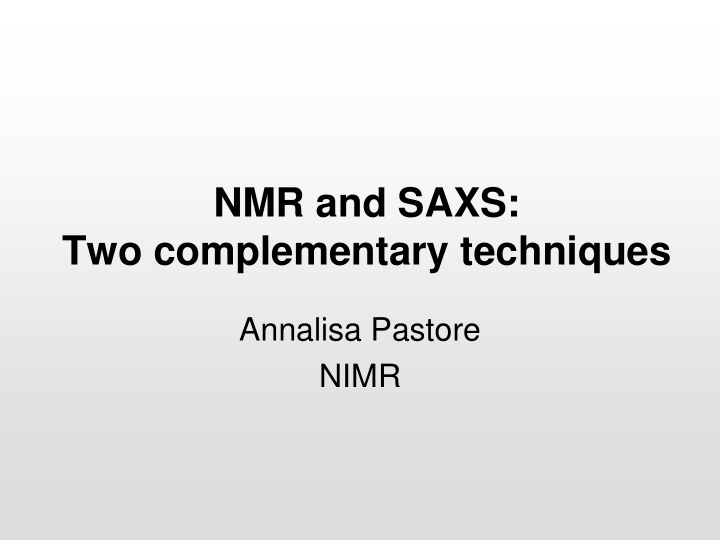



NMR and SAXS: Two complementary techniques Annalisa Pastore NIMR
A pact of friendship... SAXS NMR
Nuclear Magnetic Resonance • Structure determination • Intermolecular interactions • Dynamics • Other chemical properties
NMR sample
The 1D spectrum of a protein
Hetero-nuclear spectra: a fingerprint
Chemical shift perturbation as a tool to map interactions…
The linewidth is roughly proportional to the correlation time We are limited in the molecular size we can afford…
We think of proteins as globular objects…
Proteins are like tangrams… A limited number of building blocks is sufficient to produce different figures
A limited number of building blocks is sufficient to produce different proteins... …combinatorial possibilities
A cut-and-paste approach SAXS can help…
Some examples - Titin: how to obtain the overall shape - Ataxin 3: how to validate a structure - High molecular weight complexes
The titin case…
The Sarcomere
How can we solve the structure of titin? - It is 3 Million Da (ca. 27,000 residues) - It is a filament ca. 1 μ long
Selection of three modules as: A71
M5 – M line
I27 – I band
A71
How do they assemble in series? Fn-Fn Ig-Fn Fn-Ig Ig-Ig
What is their relative orientation?
Chemical shift additivity
One does not perturb the spectrum of the other… They do not interact with each other!
Relaxation measuraments Rotational correlation times were separately obtained I27 5.75+/-0.26 - I28 - 6.55+/-0.33 I27I28 13.18+/-1.41 12.93+/-1.48 I27gggI28 9.85+/-1.26 9.43+/-1.01 This suggests that I27I28 behaves like a rigid rod
Titin modules are assembled as beads in a necklace
Bases of passive elasticity Von Castelmur et al., PNAS 2007
The case of ataxin-3
Spinocerebellar ataxia type-3 (SCA3) or Joseph-Machado disease (MJD) is hereditary and dominant Thought to have originated from founders in the Iberia Peninsula, who migrated to the Azores and to other countries including Japan It is caused by polyQ expansion in ataxin 3, a small protein (42 kDa) mapped on chromosome 14 (14q32.1) It leads to great motor disability, without ever altering the intellect, until the death of the patient.
PolyQ diseases are dominant hereditary pathologies caused by a trinucleotide expansion n<35 CAG Expansion in coding regions folded protein (CAG)n (Gln)n n>35 Apoptosis Toxic aggregates At least 8 Polyglutamine (polyQ) expansion diseases
The solution structure of ataxin-3 polyQ Josephin …consists of the Josephin domain and of an unstructured tail which comprises polyQ Masino et al. (2002) Febs Lett. 513, 267-272
polyQ Josephin is a polyUb Joseph in cysteine protease 1-182 GST-Ub52 Glu9 Cys14 His119 Asn134
The hairpin behaves as a waving MD simulations hand
One month later… 1yzb 2aga Which is the correct structure?
Small angle scattering Only one structure fits the data: ours!!!
Structure of the josephin/Ubiquitin complex Complex josephin/ distal Ub
The case of frataxin
Friedreich’s ataxia A lethal neurodegenerative disease • Is the most frequent hereditary ataxia • 1 in 50,000 affected individuals but (being recessive) • 1 in 120 carriers in European population!!! Associated with: – Progressive gait and limb ataxia – Lack of leg reflexes – Disarthria – Diabetes mellitus • Death often caused by cardio-hypertrophy
Friedreich’s ataxia is caused by expansion of the trinucleotide GAA and partial silencing of frataxin Campuzzano et al., 1996
A thick fog… What is frataxin function?
Increasing evidence links frataxin to Fe-S cluster assembly… GST-pull down Bioinformatic evidence Huynen et al. (2001) Hum. Mol. Genet. 10, 2463-2468 Genetic and biochemical evidence Gerber et al. (2003) EMBO reports 9 , 906 Layer et al. (2006) JBC 10,1074 Muhlenhoff et al. (2002) EMBO J. 22, 4815 Ramazzotti et al. (2004 ) FEBS Lett. 557 , 215 Yoon and Cowan (2003) JACS 125, 6078
Iron sulfur clusters Iron sulphur clusters are the eldest response to the problem of storing iron and sulfur in a non-toxic form
Fe-S assembly is centred on a desulphurase and a transient acceptor 2Cys 2Ala + S-S Converts Cys into Ala IscS dimer = desulphurase iscU iscU iscU Fe2+ + IscS IscS IscS Cys Ala
Frataxin binds IscS weakly but stoichiometrically Frataxin Kd 27+/- 2 uM N 0.97 +/- 0.05 We pull-down endogenous IscS But not of IscU! Calorimetry studies
We have the structures of all three components… What is the structure of the complex?
Getting crystals of IscS/IscU or IscS/frataxin complexes A different approach… based on NMR, SAXS and mutagenesis
Frataxin and IscU do NOT compete for the same IscS surface 55 50 48 50 46 44 Fluorescence Fluorescence 42 45 - frataxin + frataxin 40 40 38 36 34 35 K d (IscU) = 0.9 +/- 0.4 μ M K d (IscU) = 1.2 +/- 2 μ M 32 30 30 0 5 10 15 0 5 10 15 [IscS] ( μ M) [IscS] ( μ M)
SAXS (Small-angle X-ray Scattering)
SAXS on IscS
SAXS DATA on IscS+IscU IscS – IscU
SAXS of IscS+frataxin
How can we get the interaction surfaces? frataxin IscU IscS
The interacting surface maps onto a conserved region of CyaY the residues involved are those necessary for iron binding!
Interacting surface on IscU 180° IscU
HADDOCK calculations
OUR SAXS + NMR model…
pdb : 3LVL
The crystal structure in our model…
The low resolution structure of the CyaY/IscS complex R220 R223 R225
The ternary IscS/IscU/CyaY complex The interaction is iron independent
Validating the model…
Search for a complementary patch of residues on IscS
Only the IscS_I314E_M315E mutant does not bind to IscU
Only IscS_R220ER223ER225E mutant abolishes binding to frataxin
Saxs and NMR as complementary techniques! To model big multidomain proteins and complexes To validate a structure
Acknowledgements Titin project: Sabina Improta, Mark Pfuhl, Claudia Muhle, Catherine Joseph Siegfried Labeit (EMBL), Mathias Gautel (EMBL), Jill Trewhella (Los Alamos) Ataxin-3 project: Giuseppe Nicastro, Laura Masino Dmitri Svergun (EMBL) Frataxin project: Filippo Prischi, Salvatore Adinolfi, Clara Iannuzzi, Peter Konarev and Dmitri Svergun (EMBL)
Recommend
More recommend